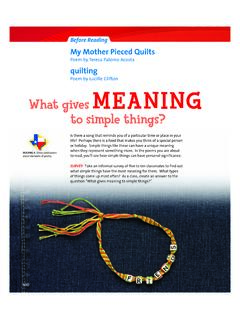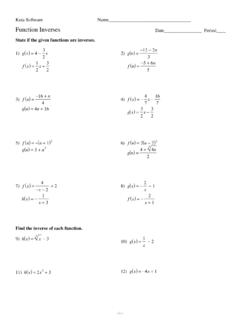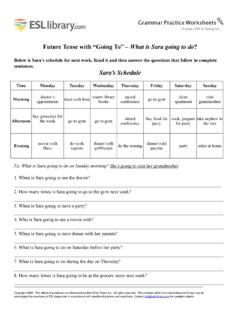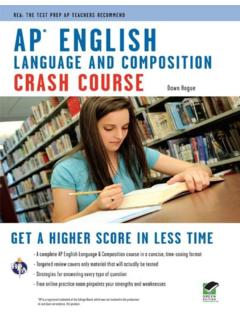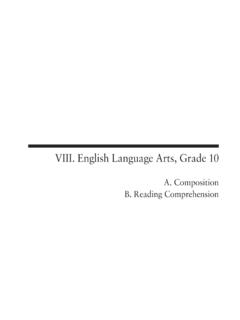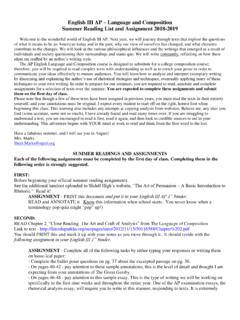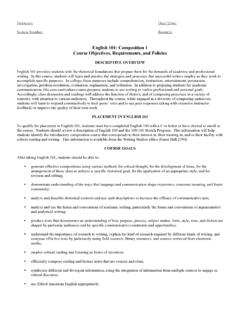Transcription of ENGLISH LANGUAGE AND COMPOSITION …
1 ENGLISH LANGUAGE AND COMPOSITION EXEMPLAR UNITS SENIOR ADVANCED PLACEMENT ENGLISH LANGUAGE & COMPOSITION SUMMER 2016 2 BELLMORE-MERRICK CENTRAL HIGH SCHOOL DISTRICT BOARD OF EDUCATION 2016-2017 Janet Goller, President Nancy Kaplan, , Vice President Marion Blane Lisa Katz JoAnn DeLauter Nina Lanci Wendy Gargiulo Gina Piskin CENTRAL ADMINISTRATION John DeTommaso Superintendent of Schools Mara Bollettieri, Deputy Superintendent Kate Freeman David Seinfeld Assistant Superintendents 3 ENGLISH LANGUAGE AND COMPOSITION SENIOR LEVEL ENGLISH Written by: Sean Formato (Calhoun High School) Michael Cooney (Mepham High School) Project Administrator: Adeline N. Atkins District Chairperson - ENGLISH 4 TABLE OF CONTENTS UNIT PAGE NUMBERS INTRODUCTION 5 SCOPE AND SEQUENCE 6-8 EXEMPLAR UNIT 1: IDENTITY AND GENDER EXPRESSION 9-61 EXEMPLAR UNIT 2: INJUSTICE: PERCEPTION AND PERSUASION 62-136 5 INTRODUCTION THIS CURRICULUM GUIDE WAS CREATED IN RESPONSE TO THE NEW OFFERING OF THE ENGLISH LANGUAGE AND COMPOSITION COURSE ( ENGLISH 4AP LANGUAGE ).
2 WRITERS CREATED MINI-UNITS OF STUDY WHICH ADDRESS CLOSE READING, SYNTHESIS, ARGUMENTATION AND RHETORICAL ANALYSIS THROUGH A VARIETY OF GENRES SUCH AS: SPEECHES, EDITORIALS, ARTICLES, ESSAYS, FICTION, AND VISUAL TEXTS. THESE EXEMPLARS ADDRESS THE VARIED SKILLS AND ASSESSMENTS WITHIN THE ENGLISH LANGUAGE AND COMPOSITION CURRICULUM. THIS CURRICULUM GUIDE CONTAINS A YEARLY OVERVIEW OF SKILLS AND ASSESSMENTS TO BE COVERED, DIVIDED BY QUARTER. ADDITIONALLY, LESSON PLANS, ACTIVITIES, AND ASSESSMENTS EMULATE SKILLS AND TASKS ASSESSED ON THE ENGLISH AP LANGUAGE EXAM. THIS COURSE WILL BE OFFERED FOR THE FIRST TIME IN SEPTEMBER 2016. 6 Scope and Sequence ENGLISH 4 Advanced Placement ENGLISH LANGUAGE and COMPOSITION Course Quarter 1: Content Focus: Skills: Potential Materials/Units/Assignments: Rhetorical Analysis SOAPSTONE Rhetorical Appeals: Logos, Ethos, Pathos Rhetorical Devices: Tone, Diction, Detail, Syntax Modes of Discourse & Text Structures: Argumentation, Narration, Description, Exposition Text Structures: Cause and Effect, Compare and Contrast, Problem and Solution, Description Close Reading Strategies (annotation, text coding, interrupted reading, etc.)
3 AP style multiple choice Senior AP LANGUAGE and COMPOSITION Guide LANGUAGE of COMPOSITION Various essays and speeches Selections from Arguing Through the Common Core Teacher selected materials Literature as Rhetoric 7 Quarter 2: Content Focus: Skills: Potential Materials/Units/Assignments: Argumentation Persuasive Writing Structure of an Argument Thesis Types of Evidence Counter Argument SOAPSTONE Rhetorical Appeals: Logos, Ethos, Pathos Modes of Discourse: Argumentation, Narration, Description, Exposition Text Structures: Cause and Effect, Compare and Contrast, Problem and Solution, Description Rhetorical Devices: Tone, Diction, Detail, Syntax Logical Fallacies Close Reading Strategies AP style multiple choice Senior AP LANGUAGE and COMPOSITION Guide LANGUAGE of COMPOSITION Arguing Through the Common Core Curriculum Unit Academic Controversy Debates Teacher selected materials 8 Quarter 3: Content Focus: Skills: Potential Materials/Units/Assignments: Synthesis/Research Consider task, purpose, and audience Gather information Evaluate sources Cite material accurately (parenthetical documentation, footnotes, works cited) APA vs.
4 MLA Report research findings and analysis of sources in a clear and cogent manner Make improvements to a piece of writing over multiple drafts Use various presentation technologies Senior AP LANGUAGE and COMPOSITION Guide LANGUAGE of COMPOSITION Academic Controversy Researching Through the Common Core College Board Synthesis Prompts 9 Summary of Contents: Unit 1 Big Idea: Identity and Gender Expression Essential Questions: What is gender? How do people express gender? How have views of traditionally male and female behavior and attributes changed over time? How have expressions of gender defined our roles in society? How does gender expression influence a person s identity? How do institutions reinforce gender conformity? Anchor Text: Woolf, Virginia. A Room of One s Own. 1929. (Excerpt) Supplemental Texts: Walker, Alice. In Search of Our Mothers' Gardens: The Creativity of Black Women in the South.
5 In Search of Our Mothers Gardens. 1974. Adichie, Chimamanda Ngozi. We Should All Be Feminists. Ted Talk. Lego ad from 1981 Lego box from 2011 Friedan, Betty. I Say: Women are People, Too! Good Housekeeping. September 1960 Adichie, Chimamanda Ngozi Why Can t a Smart Woman Love Fashion? Elle. 10 GRADE LEVEL: 12 Big Idea: Identity and Gender Expression Lesson Topic: Identifying the relationship between speaker and audience Lesson 1 One Class Period Aim: What is the relationship between speaker and audience? Common Core Learning Standards: Standard Grade Standard Number RI 12 1 W 12 1 SL 12 1, 3 L 12 1, 2, 6 Motivation: If I asked you to speak about women and fiction, how would you respond? How qualified are you to answer this question or discuss this matter? Instructional Materials: Excerpt from A Room of One s Own by Virginia Woolf (Attachment 1) Procedures and Pivotal Questions: Teacher will solicit responses to the motivation question.
6 Most students will not be able to answer or even approach the question, which is the intended response. Explain the context for the question Virginia Woolf, a well-known author, was asked to lecture on the topic of Women and Fiction to two women s colleges at Cambridge University. This essay is based on those lectures. After revealing this information, ask the class again how they would respond to the motivation. What makes Virginia Woolf a compelling speaker on this topic? Why would this particular audience be receptive to her presentation? Transition: As a class, we will be studying this essay, and analyzing the strategies Woolf uses to connect to her audience. Put the first paragraph on the smart board/overhead. Ask students to silently read the first paragraph and identify any words or phrases that contain direct or indirect appeals to the audience by annotating them with the letter A.
7 Model the first example: But, you may say, we asked puts words in the audience s mouth and gives voice to their potential thought process. After the activity, have students label the smart board with the letter A as appropriate. Is this relationship between lecturer and student typical? Why or why not? How does Woolf complicate this relationship? What effect does this have on her initial credibility? 11 Summary: What narrative persona does Woolf craft in the first paragraph? How will this play with an audience of women college students? Why would she choose this persona instead of projecting her considerable authority in this matter? Extension Activity: Students will read the rest of the piece and annotate for appeals to the audience as done in class. 12 Attachment 1 A Room of One s Own (excerpt) Virginia Woolf ONE But, you may say, we asked you to speak about women and fiction what has that got to do with a room of one s own?
8 I will try to explain. When you asked me to speak about women and fiction I sat down on the banks of a river and began to wonder what the words meant. They might mean simply a few remarks about Fanny Burney; a few more about Jane Austen; a tribute to the Bront s and a sketch of Haworth Parsonage under snow; some witticisms if possible about Miss Mitford; a respectful allusion to George Eliot; a reference to Mrs. Gaskell and one would have done. But at second sight the words seemed not so simple. The title women and fiction might mean, and you may have meant it to mean, women and what they are like; or it might mean women and the fiction that they write; or it might mean women and the fiction that is written about them; or it might mean that somehow all three are inextricably mixed together and you want me to consider them in that light. But when I began to consider the subject in this last way, which seemed the most interesting, I soon saw that it had one fatal drawback.
9 I should never be able to come to a conclusion. I should never be able to fulfil what is, I understand, the first duty of a lecturer to hand you after an hour s discourse a nugget of pure truth to wrap up between the pages of your notebooks and keep on the mantelpiece for ever. All I could do was to offer you an opinion upon one minor point a woman must have money and a room of her own if she is to write fiction; and that, as you will see, leaves the great problem of the true nature of woman and the true nature of fiction unsolved. I have shirked the duty of coming to a conclusion upon these two questions women and fiction remain, so far as I am concerned, unsolved problems. But in order to make some amends I am going to do what I can to show you how I arrived at this opinion about the room and the money. I am going to develop in your presence as fully and freely as I can the train of thought which led me to think this.
10 Perhaps if I lay bare the ideas, the prejudices, that lie behind this statement you will find that they have some bearing upon women and some upon fiction. At any rate, when a subject is highly controversial and any question about sex is that one cannot hope to tell the truth. One can only show how one came to hold whatever opinion one does hold. One can only give one s audience the chance of drawing their own conclusions as they observe the limitations, the prejudices, the idiosyncrasies of the speaker. Fiction here is likely to contain more truth than fact. Therefore I propose, making use of all the liberties and licences of a novelist, to tell you the story of the two days that preceded my coming here how, bowed down by the weight of the subject which you have laid upon my shoulders, I pondered it, and made it work in and out of my daily life. I need not say that what I am about to describe has no existence; Oxbridge is an invention; so is Fernham; I is only a convenient term for somebody who has no real being.
